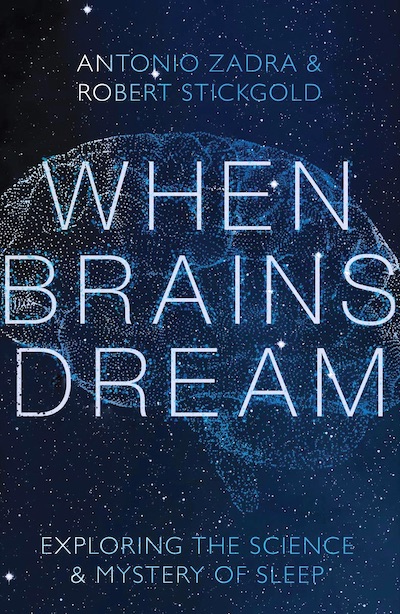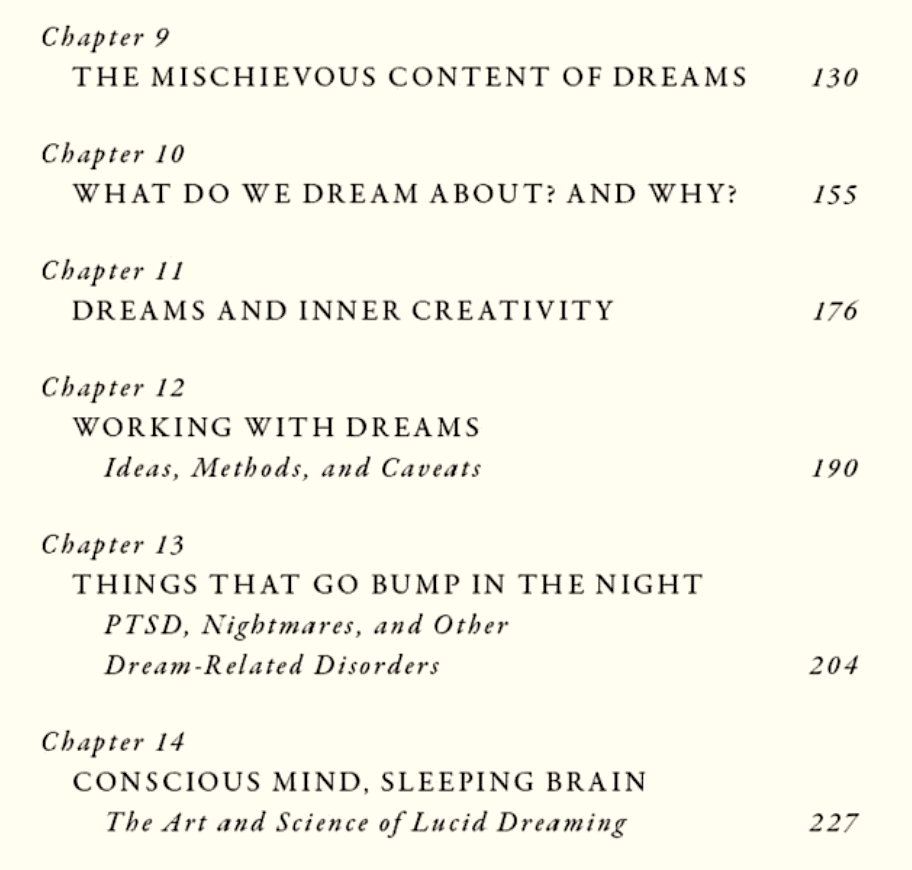 Have you ever awakened, remembered a dream, and wondered “What in the world did that mean?”
Have you ever awakened, remembered a dream, and wondered “What in the world did that mean?”
If you dream a lot, I imagine your answer is “yes.” While I forget most of my dreams, some dreams repeat or persist in my mind. So when I saw a link to one of the Next Big Idea Club “book bites” promising some science-based chat about one of our most intriguing human traits, I decided to invest what turned out to be an engaging 20 minutes listening to the NBIC podcast.
The book is When Brains Dream: Exploring the Science and Mystery of Sleep, by Antonio Zadra and Robert Stickgold. Zadra is a sleep and dream scientist at the Hôpital du Sacré-Coeur’s Center for Advanced Research in Sleep Medicine and professor of psychology at the Université de Montréal. Stickgold is a full professor of psychiatry at the Harvard Medical School and a sleep researcher who focuses on the relationship between sleep and learning.
5 Surprising Things about Sleep and Dreaming
During the 19-minute podcast, the authors highlight five key findings from their book and research.
Finding One: Both as a concept and experience, dreams are much trickier than most people imagine. For young children, dreams are real. It isn’t until they reach the ages of 6-8 that they understand dreams are both imaginary and can’t be “seen” by other people nearby.
Additionally, some people experience “false awakenings” where their brains “fool them” to believe they are awake, when they are actually asleep. The authors describe a situation where someone, still asleep, got out of bed, took a shower, got dressed and headed to the kitchen to prepare breakfast when they awoke. Fortunately, for me, I don’t think I’ve ever experienced something like that!
 Finding Two: Dream research was being done long before Freud. Before you skip this finding thinking it too theoretical, the authors point out some interesting facts. First, while you can dream throughout the night, most dreams occur in the early morning. Another interesting reminder about dreams is that our senses can transmit information to the brain during sleep. As an example, can you remember a time that you incorporated a buzzing alarm into your sleep? Or sensed the restless movement of a child in a nearby bedroom?
Finding Two: Dream research was being done long before Freud. Before you skip this finding thinking it too theoretical, the authors point out some interesting facts. First, while you can dream throughout the night, most dreams occur in the early morning. Another interesting reminder about dreams is that our senses can transmit information to the brain during sleep. As an example, can you remember a time that you incorporated a buzzing alarm into your sleep? Or sensed the restless movement of a child in a nearby bedroom?
Finding Three: Your brain needs to sleep to learn. Scientists have discovered that for every two hours we are awake and processing new information, our brain needs one hour of sleep to process what we’ve learned and done. Surprisingly, while our body is resting, our brain works “at full speed” all night long, stabilizing selected memories and strengthening skills.
In fact, the authors note that “When you wake up each morning, you literally have a better understanding of how the world works than you had when you went to bed the night before.” On the other hand, sleep deprivation (Bob Stickgold’s specialty) slows down learning and can endanger our health in significant ways. Valuable knowledge to share with students and families.
Finding Four: Dreaming serves an important sorting function. During sleep, your brain examines new memories to discern what they mean. Sleep helps the brain decide which of those memories or skills should be strengthened and which memories and skills are less important. Worth thinking about in the context of our current emphasis on “teaching what matters most.” Here’s an excerpt from the book:
“…One of Bob’s favorite tasks is his finger-tapping task, which…involves learning to type the sequence 4–1–3–2–4 as quickly and accurately as possible. Young participants get a lot better in just a couple of minutes of practice, but then they plateau. A period of rest in the same day doesn’t make them any faster, but if they get a night of sleep and then try again, they become 15 to 20 percent faster. It’s another example of sleep-dependent memory evolution.”
Finding Five: Much like art, dreams can hold multiple meanings. When puzzling over a dream, the authors suggest you ask yourself questions about the dream. Some of the ones mentioned during the book bite include:
- How did you feel during the dream?
- What was the central emotion in the dream?
- When did you last feel that way?
- What was the setting of the dream?
- Who was in the dream and what did they remind you of?
Based on these questions, you might be able to figure out the “why” of that particular dream. You’ll find a “deep dive” into dreams in the later chapters of the book. Look at these tempting chapter titles:
So if you find your dreams fascinating (or troubling), a new resource is at hand. When Brains Dream: Exploring the Science and Mystery of Sleep is available in print, at Audible, and in Kindle format (for about $9). Here’s the Amazon page, where you can click the book cover at the left and read some excerpts.
You’ll find another excerpt at The Scientist website – this one offers an inside peek at how scientists actually do brain and dream research. “As more and more brain imaging studies were published, it slowly became clear that something strange was happening….”
This is probably not traditional “beach reading” – but maybe a hammock? As you rock gently in the breeze and find yourself falling asleep, perhaps you’ll have sweet (or especially interesting) dreams.


0 Comments on "Brain Research: Sleeping and Dreaming Help Us Learn and Remember"